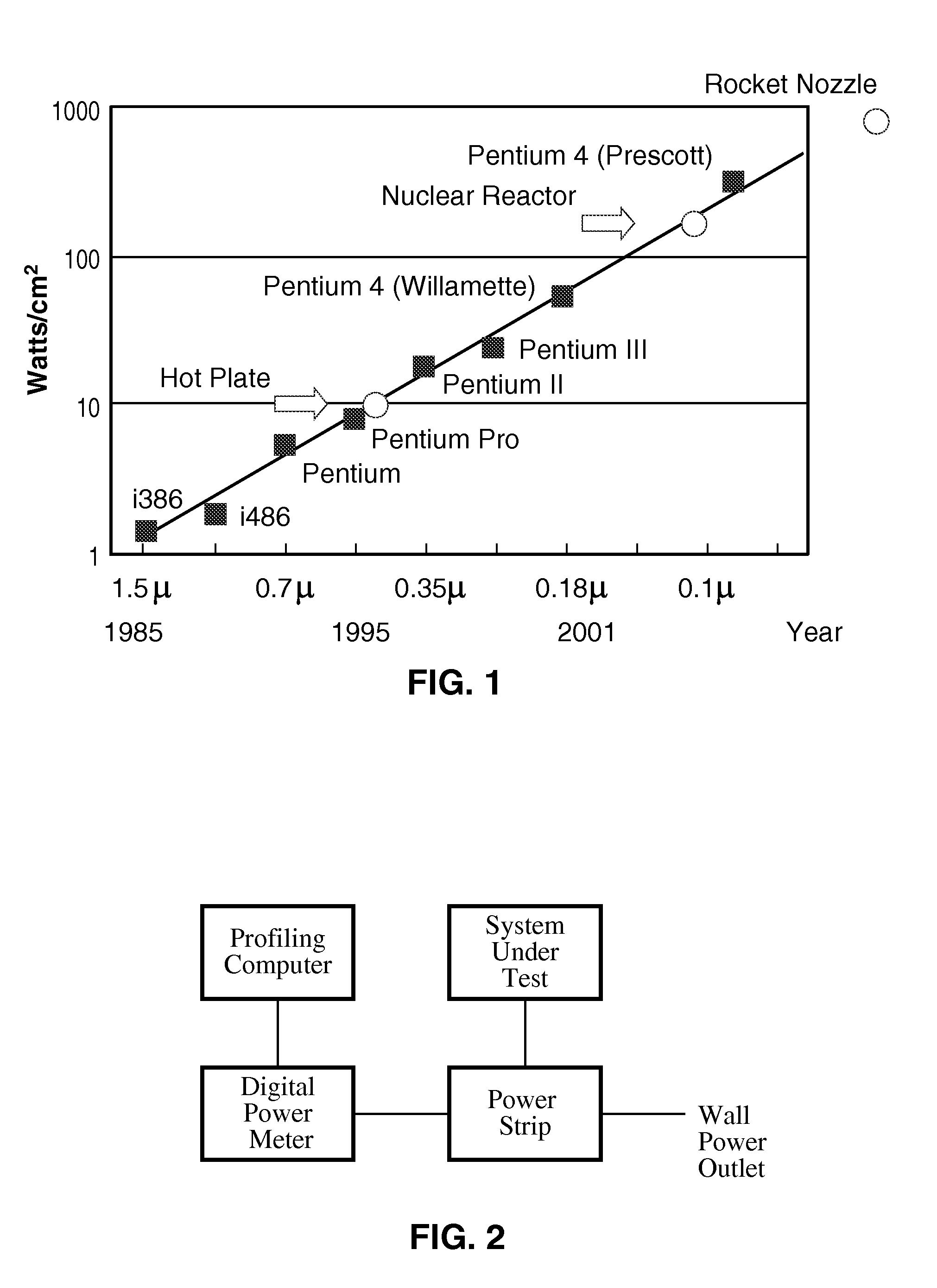Adaptive real-time methodology for optimizing energy-efficient computing
- Summary
- Abstract
- Description
- Claims
- Application Information
AI Technical Summary
Benefits of technology
Problems solved by technology
Method used
Image
Examples
example a
[0093] A.1. Testing Platform
[0094] Computer Hardware. An HP® notebook computer. This computer included a mobile AMD Athlon XP® 2200+ processor with a 256-KB level-two cache, 256-MB DDR SDRAM memory, 266-MHz front-side bus, a 30-GB hard disk, and a 15-inch TFT LCD display. The CPU supports five frequency-voltage settings as shown in Table 3.
[0095] Power Meter. A Yokogawa WT210™ digital power meter was used. This power meter continuously sampled the instantaneous wattage of the system at a rate of 50 kHz (i.e., every 20 μs).
[0096] Operating System. Linux 2.4.18.
[0097] Benchmarks. A set of representative SPEC (Standard Performance Evaluation Corporation) CPU95 benchmarks was used for the experiments. These benchmarks emphasize the performance of the CPU and memory, but not other computer components such as I / O (disk drives), networking, or graphics.
[0098] DVFS Algorithms. Five DVFS algorithms, in addition to that of the present invention.
[0099] Testing and Measurements. All bench...
example b
[0103] B.1 Testing Platform
[0104] Computer Hardware. A desktop computer based on an Asus K8V Deluxe motherboard. This computer includes an AMD Athlon64 3200+ processor with a 1 -MB level-two cache and 1 -GB DDR-400 SDRAM memory. The CPU supports four frequency-voltage settings as shown in Table 5.
[0105] Power Meter. As in Example A.
[0106] Operating System. Linux 2.6.7
[0107] Benchmarks. The SPEC CFP95 and CPU2000 benchmarks.
[0108] DVFS Algorithms. The method of the present invention and a compiler-based DVFS algorithm.
[0109] Testing and Measurement. The SPEC CFP95 benchmarks were compiled using the GNU compiler 3.3.3 with optimization level −03. The CPU2000 benchmarks were compiled using the Intel compiler 8.1 with the optimization level −xW −ip −03.
[0110] B.2. Test Results
[0111]FIG. 3 shows a comparison of the actual performance slowdown between the method of the present invention (denoted as beta) and the compiler approach (denoted as hsu) for SPEC CPU95 benchmarks. It can ...
example c
[0113] C.1 Testing Platform
[0114] Computer Hardware. Two multiprocessor-based computers. One is a cluster of four Athlon64-based desktop computers as in Example B connected via Gigabit Ethernet. The other is a cluster of four quad-CPU Celestica A8440 servers connected via Gigabit Ethernet. Each Celestica A8440 server includes four AMD Opteron 846 processors with 4-MB level-two cache and 4-GB DDR-333 SDRAM memory. The CPUs support four frequency-voltage setting as shown in Table 5.
[0115] Power Meter. Yokogawa WT230.
[0116] Operating System. Linux 2.6.7
[0117] Benchmarks. NAS (NASA Advanced Supercomputing) MPI benchmarks, version 3.2.
[0118] DVFS Algorithms. The method of the present invention.
[0119] Testing and Measurement. All benchmarks were compiled using the GNU compiler 3.3.3 with optimization level −03. LAM / MPI version 7.0.6 was used to run the benchmarks.
[0120] C.2. Test Results
[0121] For the Athlon64 cluster, FIG. 5 shows the actual performance slowdown and CPU energy sa...
PUM
 Login to View More
Login to View More Abstract
Description
Claims
Application Information
 Login to View More
Login to View More - R&D
- Intellectual Property
- Life Sciences
- Materials
- Tech Scout
- Unparalleled Data Quality
- Higher Quality Content
- 60% Fewer Hallucinations
Browse by: Latest US Patents, China's latest patents, Technical Efficacy Thesaurus, Application Domain, Technology Topic, Popular Technical Reports.
© 2025 PatSnap. All rights reserved.Legal|Privacy policy|Modern Slavery Act Transparency Statement|Sitemap|About US| Contact US: help@patsnap.com



